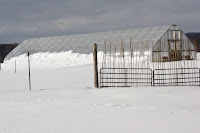
Ben here. It's hard to believe we're already half way through June- the month is passing by like an afternoon shower! The past month has been full of activity here at the Local Food Project. So full, in fact, that we haven't kept up with this blog as much as we would like. Since so much has happened, let's lean on this writer's favorite crutch: bullet points. Here's a smattering of what we've been up to at the LFP:
-We attended another great CRAFT program event at The Farm at Sunnyside. A great turnout and a lot of great food! (See the post from 4/19 for more about the CRAFT program.)
-Pablo contributed an article to Flavor Magazine describing the CRAFT program its value to aspiring farmers.
-We planted 30 beds (2700 sq ft) of squash, cucumbers, zucchini, lettuce mix, and beets... in one day!

-Filled the hoop house with tomatoes, peppers, and egg plant.
-Completed various infrastructure projects such as reinforcing our deer fence and cutting new row cover.
-Humanely trapped a family of groundhogs whose home was not even ten feet from our squash beds. We dropped them off far away from the garden. I believe a groundhog is born with the right to look for his shadow, as long as that shadow is not cast on our crops.
-Hosted several tours and a team building dinner with guests at the Airlie Center.
Last, but certainly not least, we acquired two interns to (do all of the) work for us during the next 6-8 weeks. Welcome Shaina and Yuka!

Now you're up to speed. We have another CRAFT event this week and plants growing quickly, so we'll have more to report soon.


















